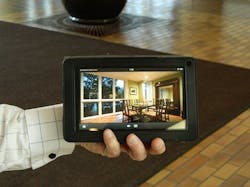Hands-on review: Kindle Fire for remodelers
The Kindle Fire from Amazon has captured a lot of buzz since its launch in November, quickly establishing itself as the No. 2 tablet on the market (by market share.) But does it offer an effective alternative to the iPad for remodelers? Here’s an examination of the pros and cons based on our hands-on look at the Fire.
Pro: Price
Let’s get one thing out of the way right away: a Fire is not an iPad. If you buy it expecting the full functionality of the iPad, you’re going to be disappointed. That said, its $199 price makes it attractive for buying multiples for employees. You can get two Fires (and throw in an e-ink Kindle reader) for less than the price of the lowest-priced iPad.
Con: No cameras
One of the big advantages of the iPad and other higher-priced tablets is that you can take photo and video with them and immediately work with the files on the tablet. The Fire has no built-in camera, so photos and video files have to be transferred either via Web or a direct connection with a desktop/laptop.
Pro/Con: Size
The Fire has a 7-inch screen versus the 10-inch screen of the iPad and most Android tablets. It also weighs a little less than those larger tablets. This means the Fire fits comfortably in one hand and doesn’t feel heavy even with long-term use. The downside of this is that the screen does not display the full versions of some websites comfortably and there’s less space to show off project beauty shots, plans, etc.
Pro: Screen display
Amazon didn’t skimp on the display. Even with hours of use, eye strain wasn’t a problem, whether using apps, reading or watching video. There’s some glare in direct light, but that’s true of any tablet.
Con: WiFi only
This could be a big one. The first version of the Fire is WiFi only, while most other tablets are available in a 3G- or 4G-enabled version that allows you to connect to the Web just like you would with your mobile phone.
If you’re planning on being truly mobile and connecting from anywhere, it could be a dealbreaker. (Using your phone as a mobile hotspot is a possible, although somewhat clunky, workaround.)
Con: Hard drive
The Fire is designed for working off the cloud, and its 8 GB of storage is half that of the lowest-end iPad. It’s also a little slower (barely noticeable, but it’s there) than most other tablets.
Con (for now): Apps
The Amazon Appstore doesn’t have as many apps as Apple’s or the Android Market right now, but developers are quickly adding apps as the Fire’s popularity grows. You can also sideload Android apps by tweaking a few settings on the Fire, which expands the options.
Pro: Ecosystem
Unlike other would-be iPad competitors, the Fire is backed by a company that has great content. Just like Apple, Amazon has a great relationship with content providers. From a business standpoint this may not be important, but if you want to use your tablet in your off-hours, when traveling, etc., it’s nice to have that.
In the end, it all comes down to how you are going to use the device. Just a digital portfolio? Using it just in a showroom where your employees have full access to WiFi? The Fire is a great way to go. Want to create and work with photos right on site and access the Web anywhere? Not so much.
The Fire has a lot of shortcomings when compared to many of the $500+ tablets. Still, that $199 pricetag can make up for a lot, especially if you’re in a situation where you want to buy multiple devices for employees.
